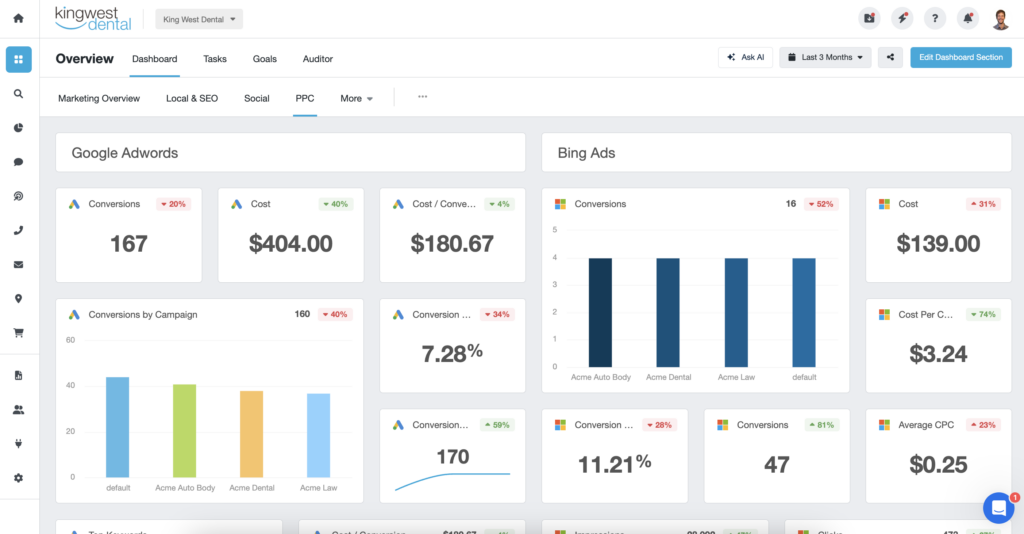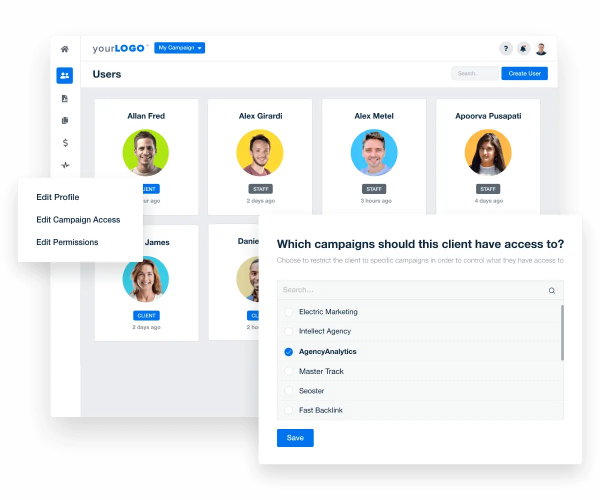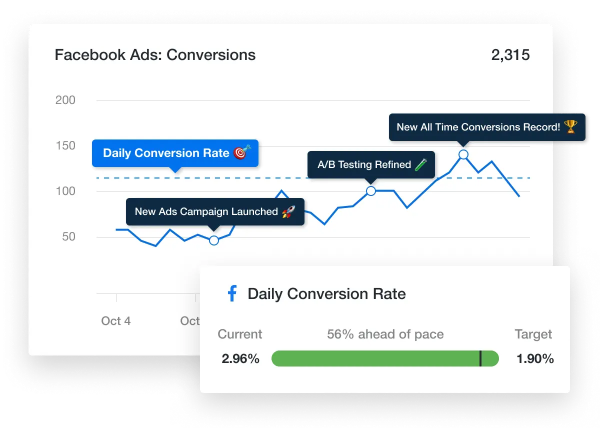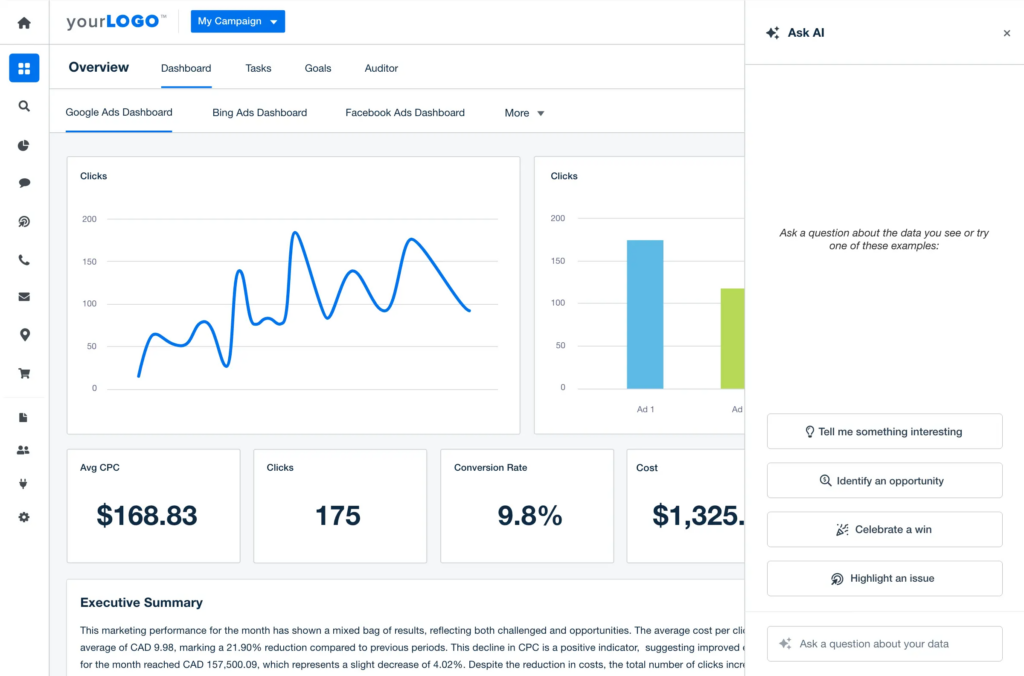Automating the tracking and reporting processes for your client’s PPC campaigns frees up valuable time that can be better spent on strategy, like optimizing campaigns or pitching new clients. Instead of getting bogged down by manual reporting, automation allows you to focus on what truly helps grow your agency—acquiring new business and building strong client relationships.
Think of it like managing a budget for a big event—you wouldn’t show your client a breakdown of every small expense, but you’d highlight the most impactful ones, like catering or venue costs. The same goes for PPC campaigns.
While you could get bogged down in click-through rates and impressions, focusing on the metrics that matter most to your client’s bottom line is more effective, like conversion rates or ROAS.
By zeroing in on these key numbers, marketers provide clearer, more valuable insights into how the campaign is performing.
In this article, we’ll share practical strategies for tracking PPC metrics that help you communicate meaningful results to your clients without overwhelming them with unnecessary details.
Topic Summary:
- Why Should Your Agency Track PPC Metrics?
- Common Challenges of Tracking PPC Metrics
- The Most Important PPC Metrics
- How To Demonstrate PPC ROI Using Automated Reporting
- Summary & Key Takeaways
Why Should Your Agency Track PPC Metrics?
Any marketer knows that tracking PPC metrics goes beyond just calculating revenue. While clients often expect their paid campaigns to directly impact sales, PPC success isn’t always reflected in immediate dollars.
For example, some clients have goals tied to actions like eBook downloads or lead form signups. These conversions don’t always have a clear dollar value, making it harder to tie them directly to ROI without additional analysis.
In these cases, it is important to monitor real-time and historical metrics alongside any other marketing efforts your client is running. Using a dashboard or detailed report allows you to spot trends and connect the dots between different campaigns, giving a more complete picture of the client’s return on investment.
Remember that metrics like brand awareness and reach are also important indicators of long-term success, even if they don’t immediately translate into sales. For example, a PPC campaign that increases brand visibility could pave the way for future conversions, which is just as valuable. Regularly tracking and communicating these broader metrics helps show clients the full scope of an agency’s efforts, building trust and demonstrating value beyond short-term revenue.
Common Challenges of Tracking PPC Metrics
Tracking PPC metrics can be tricky, even for seasoned marketers. Here are five of the most common challenges agencies face:
1. Attribution Issues
One of the biggest hurdles in tracking PPC success is accurately attributing conversions to the right channel. A user might interact with multiple touchpoints before converting, like seeing a PPC ad, engaging with organic content, and then receiving an email. It’s challenging to determine which touchpoint gets the credit. This is where multi-touch attribution models can help, but getting a clear picture is often complex.
2. Lag Between Clicks and Conversions
Sometimes, the time it takes for users to convert after clicking on an ad isn’t immediate. For example, a customer might click on an ad today but not complete a purchase until weeks later. This lag can distort short-term performance metrics and make it difficult to gauge a campaign’s immediate success. Keeping an eye on long-term trends helps smooth out this challenge.
3. Measuring Non-Revenue Goals
Not all clients measure success through revenue. Some PPC campaigns aim to drive lead generation, signups, or brand awareness, which don’t directly tie to a dollar value. It can be tough to show clients the true impact of these campaigns without clear monetary results, making it important to use other success indicators like engagement or lead quality.
4. Revenue Metrics Don’t Always Capture Your Agency’s Full Impact
PPC marketers often launch campaigns that build momentum without immediate sales. Yet, this increase in brand reach often sets the stage for future conversions. Highlighting growth in brand recognition and sharing similar success stories shows clients the long-term impact.
Also, remember that revenue metrics alone don’t reflect all the groundwork your agency puts in, like competitor PPC analysis before launch. Instead of just reporting impressions and CPM, emphasize your strategy to build client trust.
5. Limited Control Over External Influences
Even with well-optimized campaigns, certain factors remain beyond your control, such as:
- Algorithm updates (e.g., recent Google Ads and GA4 changes) that may limit ad visibility.
- Privacy regulation shifts (e.g., Apple’s mobile app tracking policy) affecting ad targeting and remarketing.
- Economic factors, like a recession, which could reduce consumer purchasing power.
When these factors impact PPC performance, proving ROI can be difficult. Maintaining open communication with clients through regular reporting helps manage expectations and ensures transparency about any external changes.
The Most Important PPC Metrics
Tracking the right PPC metrics is key to showing clients how their campaigns perform and where their investment delivers value. By focusing on specific metrics, agencies offer clients a transparent view of engagement, conversion, and revenue-driving activities. Each metric reveals insights into different aspects of campaign success, helping fine-tune strategies and meet client goals.
Here’s a breakdown of the most valuable PPC metrics for client reporting:
1. Cost per Engagement (CPE)
Cost per Engagement (CPE) measures the cost of each interaction with an ad, whether it’s a click, video view, or social share. CPE is especially relevant for awareness campaigns aiming to drive engagement over direct conversions. This metric helps clients understand how their ads capture attention and encourage interaction without solely focusing on direct sales.
2. Bounce Rate
Bounce rate indicates the percentage of users who click on an ad but leave without further interaction. A high bounce rate might mean the landing page isn’t engaging or relevant, which could affect overall campaign performance. Tracking this metric helps agencies address potential issues on landing pages, ensuring they align with user expectations and improving the chances of conversions.
3. Cost per Lead (CPL)
Cost per Lead (CPL) is an important metric for lead generation campaigns, showing how much it costs to acquire each lead. For clients focused on building a sales pipeline, CPL offers clear insight into how effectively the campaign generates potential customers within a specific budget. This metric allows clients to gauge the cost-efficiency of their PPC efforts, helping them assess the long-term value of each lead generated.
4. Conversion Rate
Conversion rate measures the percentage of ad clicks that result in a desired action, such as a purchase or signup. A high conversion rate indicates that the ad, audience targeting, and landing page are aligned and effective. This metric is one of the most common ways to gauge how well a campaign meets its objectives, providing clients with a clear sense of whether their investment translates into actionable results.
5. Cost per Action (CPA)
Cost per Action (CPA) indicates how much it costs for each user to complete a specific action, like a purchase or form submission. CPA is a valuable metric for performance-based campaigns where clients want to track the cost-efficiency of individual conversions. By monitoring CPA, agencies optimize bids and targeting to keep the cost per conversion within a sustainable range, ensuring clients maximize their return on investment.
6. Return on Ad Spend (ROAS)
Return on Ad Spend (ROAS) calculates the revenue generated for every dollar spent on advertising. ROAS is an important metric for measuring the financial return of PPC campaigns, giving clients a clear view of how well their ad spend translates into revenue. By focusing on ROAS, agencies identify high-performing campaigns and reallocate budgets to those with the best return potential.
7. Total Revenue
Total revenue represents the complete income generated from PPC efforts, clearly showing clients their campaign’s financial impact. While ROAS shows efficiency, total revenue reveals the overall dollar value through ads. Tracking this metric helps clients connect their ad investment to concrete financial outcomes and assess if campaigns meet revenue targets.
8. Total Conversions
Total conversions indicate the overall number of completed actions attributed to the campaign, such as purchases, downloads, or form submissions. This metric helps clients understand the volume of user actions that result from PPC ads, providing a broader picture of campaign effectiveness beyond cost metrics alone.
9. Average Position
Average position shows where an ad appears on the search results page, with higher positions typically leading to more visibility and clicks. This metric is key for clients seeking strong visibility in search results. Tracking average position allows agencies to adjust bids and ad quality to ensure ads maintain a competitive placement.
10. Click-Through Rate (CTR)
Click-Through Rate (CTR) measures the percentage of ad impressions that result in clicks. A high CTR indicates that the ad resonates with the target audience, making it a critical metric for gauging ad relevance. By tracking CTR, clients gain insight into how well their ads capture interest, which can help refine ad copy and targeting.
11. Impressions
Impressions refer to the number of times an ad is displayed, regardless of whether it was clicked. This metric helps clients understand the exposure their ads receive, providing insight into brand visibility. While impressions alone don’t indicate engagement, they are a foundational metric for awareness-focused campaigns and gauging overall reach.
12. Impression Share
Impression share represents the percentage of times an ad is shown out of the total available impressions for the target audience. This metric reveals how often the ad appears in relevant searches, giving clients an understanding of market reach. A low impression share could indicate missed opportunities due to budget limitations or low bids, making it a valuable metric for optimizing reach.
13. Customer Lifetime Value (CLV)
Customer Lifetime Value (CLV) estimates the total revenue a business can expect from a customer over their entire relationship. For PPC campaigns, CLV provides insight into the long-term value of acquired customers beyond just the initial conversion. By comparing CLV to customer acquisition costs (CAC), agencies help clients assess whether their ad spend brings in high-value customers who are likely to drive sustained revenue over time.
Agency Tip: Leverage a PPC report template to showcase key metrics your clients will easily understand—and look forward to receiving.
Build your first report today by signing up for a free 14-day trial with AgencyAnalytics.
How To Demonstrate PPC ROI Using Automated Reporting
Automated reporting makes it easier for agencies to show PPC ROI by giving clients clear, data-focused insights and saving time. Real-time dashboards, client access, scheduled reports, and advanced AI tools help agencies display results and maintain transparency.
Here are some foolproof ways to ensure you’re delivering valuable client reports:
Use Dashboards to Monitor Real-Time Updates
Stay on top of your client’s PPC campaigns with live dashboards:
- Use ready-made dashboard templates, and add in client-specific metrics.
- Build a comprehensive PPC dashboard that integrates paid ad metrics alongside other insights, such as organic traffic data.
- Keep track of real-time insights, making timely campaign adjustments if needed to boost performance.

Grant Client Login Access for Greater Transparency
To inform clients about their PPC progress, give them login access to their reporting dashboards. This approach will:
- Empower clients to check in on campaign progress anytime.
- Reduce the need for follow-up emails or calls, saving everyone time.
- Strengthen trust by showcasing a commitment to transparency.

Deliver Regularly Scheduled Reports
While real-time access is helpful, scheduling regular reports stabilizes metrics before sharing results. PPC campaigns often need adjustments before showing optimal performance and reporting too soon could raise unnecessary concerns.
For efficient reporting, use AgencyAnalytics to:
- Convert dashboards into reports with a single click.
- Use pre-built templates for streamlined reporting or customize as needed.
- Add an executive summary for high-level updates, ideal for C-level clients.
- Set up an automated schedule so clients receive consistent, on-time reports.

Add Annotations and Goals to Monitor Progress
Add clarity to your reports by using annotations and setting specific goals:
- Provide context directly on data visuals with comments, such as noting when increased PPC spend correlates with revenue growth.
- Track goals dynamically to show clients the progress toward their targets.

Use AI Reporting Features and Smart Reports to Save Time
AgencyAnalytics’ AI reporting tools, including Ask AI and AI Summary, provide instant insights to take your reports to the next level. Marketers quickly identify trends, insights, and growth opportunities by leveraging AI-driven data analysis.
With Ask AI, agencies:
- Get immediate answers to specific questions, providing actionable insights for client reports and campaign strategies.
- Uncover trends, spot growth opportunities, and address challenges with just one query, saving hours of manual analysis.

With 11-Second Smart Reports, agencies can:
- Generate tailored reports quickly by linking clients’ campaign integrations, from PPC to social media data.
- Each report section is automatically populated with high-impact metrics based on trends from over 6,500 marketing agencies, ensuring you’re reporting on the most relevant data in a fraction of the time.

With these best practices in place, your agency will provide detailed, timely reports that build client trust and clearly showcase PPC ROI.
Summary & Key Takeaways
To wrap up, tracking PPC metrics is important for agencies to show their value to clients and highlight campaign results. Focusing on key metrics and using automated tools helps agencies easily communicate PPC ROI without spending hours on manual reporting. These strategies simplify reporting results while keeping clients informed.
Here are some key takeaways:
- Track key metrics like ROAS, CPA, and total conversions to show clear campaign performance.
- Use automated reporting with real-time dashboards, scheduled reports, and AI insights to save time and keep clients updated.
- Provide client access and annotations so clients see the data and understand the insights behind it.
With these strategies, agencies successfully show PPC ROI, giving clients clear data without the extra work of spreadsheets and screenshots.
Try AgencyAnalytics with a 14-day free trial and start streamlining your reporting process today!
https://digitalagencynetwork.com/strategies-for-tracking-ppc-metrics/”>
#Strategies #Tracking #PPC #Metrics
